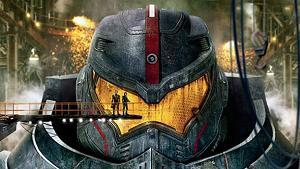 Let’s begin this review on the bluntest note possible: Pacific Rim is the summer’s best blockbuster by several leagues. That may read as grotesquely biased coming from someone who grew up on Ultraman, Ray Harryhausen, and Toho films and discovered mecha anime titles in his college years; it probably doesn’t help my case that Guillermo del Toro happens to be one of my favorite contemporary filmmakers, either. But if my loyalty to del Toro and my passion for the kaiju films he has modeled so much of Pacific Rim after give me a clear dog in the seasonal fight for popcorn supremacy, my sentiment about his latest film remains as earnest as can be.
Let’s begin this review on the bluntest note possible: Pacific Rim is the summer’s best blockbuster by several leagues. That may read as grotesquely biased coming from someone who grew up on Ultraman, Ray Harryhausen, and Toho films and discovered mecha anime titles in his college years; it probably doesn’t help my case that Guillermo del Toro happens to be one of my favorite contemporary filmmakers, either. But if my loyalty to del Toro and my passion for the kaiju films he has modeled so much of Pacific Rim after give me a clear dog in the seasonal fight for popcorn supremacy, my sentiment about his latest film remains as earnest as can be.
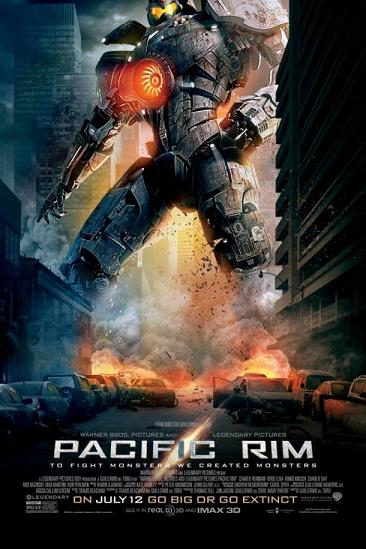 In part, that’s because del Toro doesn’t simply make movies for fans of the niche. Not that a healthy obsession with the cinematic traditions del Toro explores in Pacific Rim‘s two hour and change running time hurts, mind, but one need not watch Neon Genesis Evangelion, Robot Jox, Destroy All Monsters, or Godzilla to maximize their enjoyment of the film – and del Toro has too much imagination to construct something with superficially narrow appeal, even when he’s playing around with the blueprints for scores of movies and television shows that could be considered “acquired tastes”. (And I don’t have enough room here to properly convey the pleasures of man-in-suit monster movies to the uninitiated.)
In part, that’s because del Toro doesn’t simply make movies for fans of the niche. Not that a healthy obsession with the cinematic traditions del Toro explores in Pacific Rim‘s two hour and change running time hurts, mind, but one need not watch Neon Genesis Evangelion, Robot Jox, Destroy All Monsters, or Godzilla to maximize their enjoyment of the film – and del Toro has too much imagination to construct something with superficially narrow appeal, even when he’s playing around with the blueprints for scores of movies and television shows that could be considered “acquired tastes”. (And I don’t have enough room here to properly convey the pleasures of man-in-suit monster movies to the uninitiated.)
So it may go without saying that del Toro is Pacific Rim‘s not-so-secret weapon, save perhaps to a mainstream audience that hasn’t quite caught on to his work yet. He’s created exactly the sort of picture people rush to criticize for “ripping off” other properties, yet he has so many ideas and flourishes of his own to add to the mix that Pacific Rim easily maintains its own sense of individualism. Put another way, you’ve never seen Earth invaded by colossal alien beasts like this before. The basic conceit here involves a dimensional rift beneath the ocean that allows colossal alien beasts (referred to as “kaiju” in the film’s only obvious reference) to spill into our world and batter the planet’s populated cities. Mankind responds by by building towering war machines dubbed Jaegers, operated by two pilots mentally linked together in a neural bridge called “drift space”, to blunt the kaiju assault, but they don’t solve the problem so much as they prolong it.
By the time Pacific Rim‘s story begins in earnest following a twenty minute prologue, the kaiju have started attacking faster than Jaegers can be built, and global leaders have decided that hiding behind kaiju-proof walls (which naturally aren’t kaiju-proof whatsoever) is a better option than fighting. The end appears to be extremely nigh, but the stoic military commander Stacker Pentecost (Idris Elba) and his enigmatic assistant Mako Mori (Rinko Kikuchi) have a plan: nuke the Breach from the inside, sealing it off and repelling the kaiju invasion for good. He just needs to drag ex-Jaeger jockey Raleigh Beckett (Charlie Hunnam), a man haunted by a personal tragedy, out of self-imposed exile first.
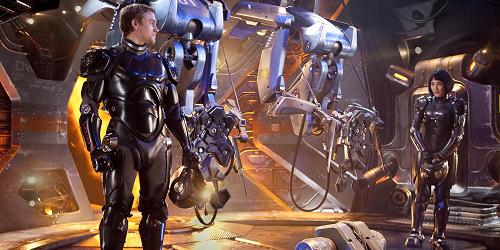
The whole thing sounds incredibly silly on paper – it’s the sort of drama children might act out in sandboxes with their action figures – but that’s half the joy of kaiju films in the first place, and the same is true for Pacific Rim. The other half, by far the more important of the two, is that del Toro dares to rewrite the grammar of the modern blockbuster by filling the space between each action set piece with intelligence, wit, and heart. A close look at del Toro’s filmography reveals a deeply compassionate and humanist filmmaker who cares about the people he populates his stories with; his greatest gift as a director, apart from his singular sense of vision, is his ability to make his audience care for them equally. Yes, Pacific Rim is a film where a Jaeger rocket-punches a kaiju square in the kisser; it’s also a film that’s as concerned with human characters as it is CG rumpuses.
That’s not to say that Pacific Rim is light on mayhem; the film’s titanic combatants wrack up some truly astronomical collateral damage just by setting foot on land. When they actually lock horns, the spectacle can only be described as eye-popping. Del Toro stages every single meeting between man and monster with unique visual identities, draping every cityscape and oceanic vista in a rainbow of rich, beautiful colors. It’s psychedelic havoc choreographed with a judicious eye for geography and movement; the second act slugfest through the streets of Hong Kong in particular is a brawl for the ages.
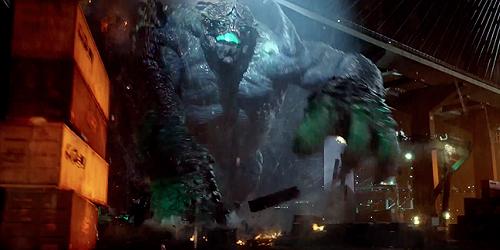
But del Toro inherently understands what makes the best kaiju and mecha stories resonate, and that’s humanity. When Eiji Tsuburaya and Ishiro Honda jammed a stuntman in a rubber suit and had him stomp across a crude miniature replica of Tokyo, they didn’t just invent a new technique for bringing gargantuan screen monsters to life; they injected their creation with unexpected empathy. Del Toro’s stable of behemoths don’t have strands of metaphor in their computer-generated DNA – they’re engines of devastation designed to sow chaos – so he places allegorical emphasis on his cast instead. Pacific Rim is about large-scale action and gleeful destruction porn, but it’s also about the desperation of hope and society’s inclination to unite and bond over common tragedy.
G-S-T Ruling:
Maybe that’s why the kaiju are such blank slates: they’re stand-ins for whatever disaster we choose to see in the carnage they wreak, whether it’s the horror of the Boston Marathon bombings or the Savar building collapse in Bangladesh. The same can’t be easily said of del Toro’s world, which bursts with delightfully rusty, retro life in every corner of every frame, or the characters he populates it with. Everyone here is drawn together over loss; Raleigh over his brother, Stacker over the men and women he sends to their deaths every single day, Mako over her family. Moreover, Pacific Rim is never not about their emotional arcs and their joint grief, even when it’s about robots scrapping with aliens. And that’s what makes the film so special: it has the audacity to be smart and heartfelt as it simultaneously indulges its fantastical elements. You may never see a more earnest picture that dresses Charlie Day as J.J. Abrams and has him run in terror from enormous, phosphorescent monsters.
If there’s justice in the world, Pacific Rim will be a hit. Reality dictates that this probably won’t be the outcome for del Toro’s biggest mainstream outing yet. No matter what the film’s fate turns out to be, however, the Mexican auteur can rest easy knowing that he’s made a movie that easily stands side-by-side with its progenitors and effortlessly makes his contemporaries in blockbuster filmmaking look like inferior craftsman.
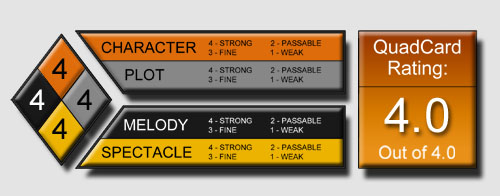
4 Comments
Jon Wilson
I was not even considering this movie, until now! G-S-T usually ranks/rates things the way my tastes run. So, my GF is in for a Sci-Fi surprize
Andrew Crump
Hope it met your expectations, Jon! Glad I could convince you to check it out for yourself, too.
RidgeRacer4
It’s big, it’s bad ass and barring a pretty slow middle (that rehashes macho 80s movies we’ve come to love) Del Toro nails another solid entry into genre filmmaking. It looks pretty, in his patented “sexy ugly” fashion, it hits hard and this behemoth of a film ends with such a fun-filled in incredibly fulfilling bang. It’s what fans want in a monster movie but it’s also what fans deserve.
Andrew Crump
Agreed completely, though that slow middle worked for me just because I was vibing on what the actors were doing. And del Toro just knows how to build worlds I want to dive into, even when they’re under attack by giant monsters!